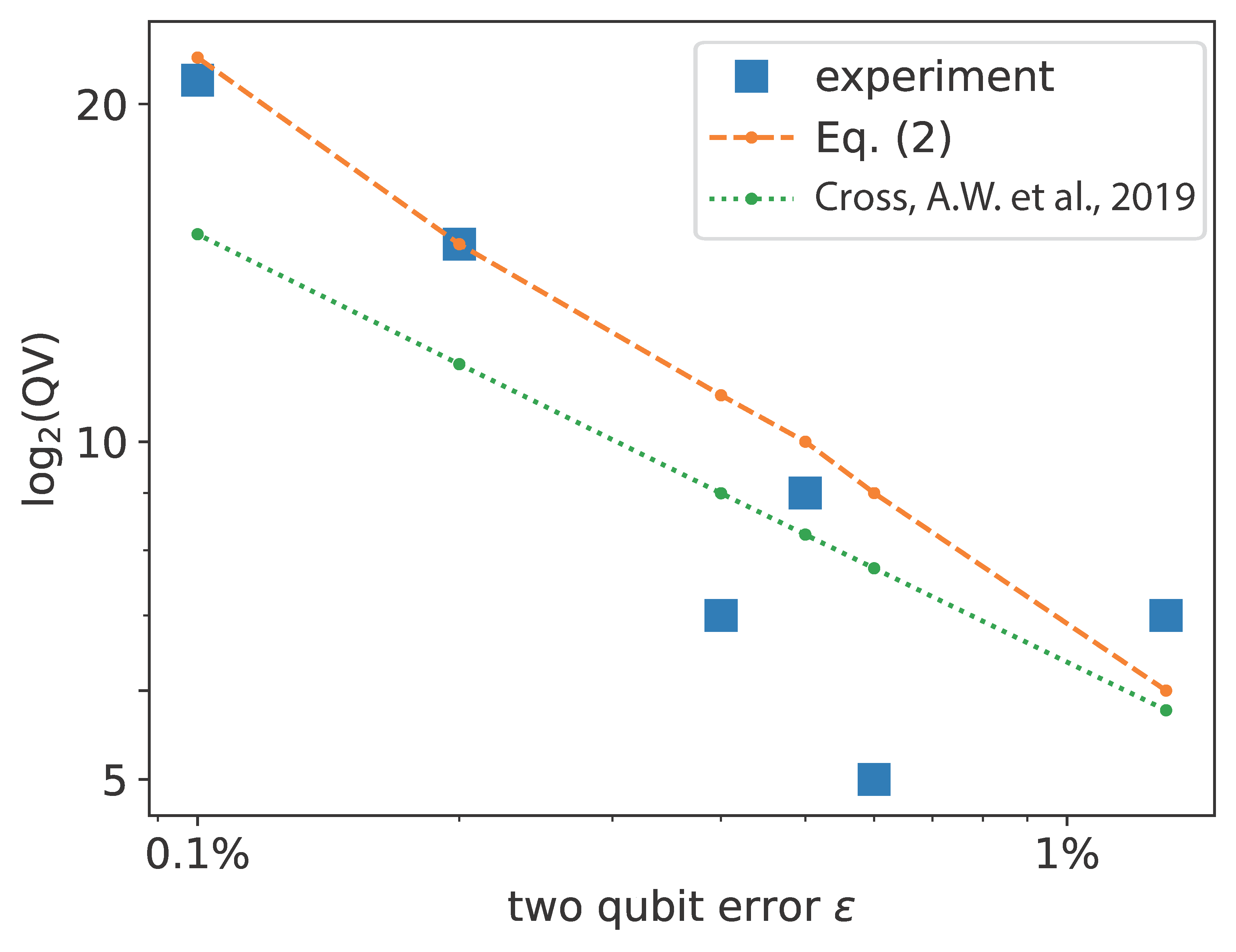Practitioners’ Rule of Thumb for Quantum Volume
Abstract
1. Introduction
2. Materials and Methods
3. Results
4. Discussion
Funding
Data Availability Statement
Conflicts of Interest
References
- Moll, N.; Barkoutsos, P.; Bishop, L.S.; Chow, J.M.; Cross, A.; Egger, D.J.; Filipp, S.; Fuhrer, A.; Gambetta, J.M.; Ganzhorn, M.; et al. Quantum optimization using variational algorithms on near-term quantum devices. Quantum Sci. Technol. 2018, 3, 030503. [Google Scholar] [CrossRef]
- Cross, A.W.; Bishop, L.S.; Sheldon, S.; Nation, P.D.; Gambetta, J.M. Validating quantum computers using randomized model circuits. Phys. Rev. A 2019, 100, 032328. [Google Scholar] [CrossRef]
- Azses, D.; Haenel, R.; Naveh, Y.; Raussendorf, R.; Sela, E.; Dalla Torre, E.G. Identification of symmetry-protected topological states on noisy quantum computers. Phys. Rev. Lett. 2020, 125, 120502. [Google Scholar] [CrossRef] [PubMed]
- Roses, M.M.; Landa, H.; Dalla Torre, E.G. Simulating long-range hopping with periodically driven superconducting qubits. Phys. Rev. Res. 2021, 3, 033288. [Google Scholar] [CrossRef]
- Sheffer, M.; Azses, D.; Dalla Torre, E.G. Playing quantum nonlocal games with six noisy qubits on the cloud. Adv. Quantum Technol. 2022, 5, 2100081. [Google Scholar] [CrossRef]
- Azses, D.; Dalla Torre, E.G.; Sela, E. Observing Floquet topological order by symmetry resolution. Phys. Rev. B 2021, 104, L220301. [Google Scholar] [CrossRef]
- Dalla Torre, E.G.; Reagor, M.J. Simulating the interplay of particle conservation and long-range coherence. Phys. Rev. Lett. 2023, 130, 060403. [Google Scholar] [CrossRef] [PubMed]
- Azses, D.; Dupont, M.; Evert, B.; Reagor, M.J.; Dalla Torre, E.G. Navigating the noise-depth tradeoff in adiabatic quantum circuits. Phys. Rev. B 2023, 107, 125127. [Google Scholar] [CrossRef]
- Sudevan, S.; Azses, D.; Dalla Torre, E.G.; Sela, E.; Das, S. Multipartite entanglement and quantum error identification in d-dimensional cluster states. Phys. Rev. A 2023, 108, 022426. [Google Scholar] [CrossRef]
- Ben-Dov, M.; Shnaiderov, D.; Makmal, A.; Dalla Torre, E.G. Approximate encoding of quantum states using shallow circuits. NPJ Quantum Inf. 2024, 10, 65. [Google Scholar] [CrossRef]
- Mallik, A.V.; Cangemi, L.M.; Levy, A.; Torre, E.G.D. Probing quantum anomalous heat flow using mid-circuit measurements. arXiv 2024, arXiv:2410.22900. [Google Scholar] [CrossRef]
- Roy, M.S.; Mumford, J.; O’Dell, D.; Torre, E.G.D. Universal scaling of quantum caustics in the dynamics of interacting particles. arXiv 2024, arXiv:2410.06803. [Google Scholar] [CrossRef]
- Pelofske, E.; Bärtschi, A.; Eidenbenz, S. Quantum Volume in Practice: What Users Can Expect From NISQ Devices. IEEE Trans. Quantum Eng. 2022, 3, 3102119. [Google Scholar] [CrossRef]
- Arute, F.; Arya, K.; Babbush, R.; Bacon, D.; Bardin, J.C.; Barends, R.; Biswas, R.; Boixo, S.; Brandao, F.G.; Buell, D.A.; et al. Quantum supremacy using a programmable superconducting processor. Nature 2019, 574, 505–510. [Google Scholar] [CrossRef] [PubMed]
- Honeywell. Quantinuum Extends Its Significant Lead in Quantum Computing, Achieving Historic Milestones for Hardware Fidelity and Quantum Volume. 2024. Available online: https://www.quantinuum.com/blog/quantinuum-extends-its-significant-lead-in-quantum-computing-achieving-historic-milestones-for-hardware-fidelity-and-quantum-volume (accessed on 8 January 2025).
- Honeywell. Quantinuum Hardware Quantum Volume Test Data. 2024. Available online: https://github.com/CQCL/quantinuum-hardware-quantum-volume/blob/main/notebooks/LoadExperimentalData.ipynb (accessed on 8 January 2025).
- Honeywell. Quantum Volume Reaches 5 Digits for the First Time. 2022. Available online: https://www.quantinuum.com/news/quantum-volume-reaches-5-digits-for-the-first-time-5-perspectives-on-what-it-means-for-quantum-computing (accessed on 8 January 2025).
- Jurcevic, P.; Javadi-Abhari, A.; Bishop, L.S.; Lauer, I.; Bogorin, D.F.; Brink, M.; Capelluto, L.; Günlük, O.; Itoko, T.; Kanazawa, N.; et al. Demonstration of quantum volume 64 on a superconducting quantum computing system. Quantum Sci. Technol. 2021, 6, 025020. [Google Scholar] [CrossRef]
- IBM Quantum. Pushing Quantum Performance Forward with Our Highest Quantum Volume Yet. 2022. Available online: https://research.ibm.com/blog/quantum-volume-256 (accessed on 8 January 2025).
- Alpine Quantum Computer. State of Quantum Computing in Europe: AQT Pushing Performance with a Quantum Volume of 128. 2022. Available online: https://www.aqt.eu/aqt-pushing-performance-with-a-quantum-volume-of-128/ (accessed on 8 January 2025).
- IBM Quantum. IBM Quantum Delivers on Performance Challenge Made Two Years Ago. 2024. Available online: https://www.ibm.com/quantum/blog/qdc-2024 (accessed on 8 January 2025).
- IBM Quantum. Quantum-Centric Supercomputing: The Next Wave of Computing. 2022. Available online: https://www.ibm.com/quantum/blog/next-wave-quantum-centric-supercomputing (accessed on 8 January 2025).
- Kim, Y.; Eddins, A.; Anand, S.; Wei, K.X.; Van Den Berg, E.; Rosenblatt, S.; Nayfeh, H.; Wu, Y.; Zaletel, M.; Temme, K.; et al. Evidence for the utility of quantum computing before fault tolerance. Nature 2023, 618, 500–505. [Google Scholar] [CrossRef] [PubMed]


| QV (Exp.) | QV (Equation (2)) | Technology | Company | Year | Ref. | |
|---|---|---|---|---|---|---|
| 0.1% | 21 | 22 | trapped ions | Quantinuum | 2024 | [15,16] |
| 0.2% | 15 | 15 | trapped ions | Quantinuum | 2022 | [17] |
| 0.4% | 7 | 10 | trapped ions | Honeywell | 2020 | [18] |
| 0.5% | 9 | 10 | supercond. circuits | IBM | 2022 | [19] |
| 0.6% | 5 | 9 | supercond. circuits | IBM | 2020 | [18] |
| 1.3% | 7 | 6 | trapped ions | AQT | 2023 | [20] |
Disclaimer/Publisher’s Note: The statements, opinions and data contained in all publications are solely those of the individual author(s) and contributor(s) and not of MDPI and/or the editor(s). MDPI and/or the editor(s) disclaim responsibility for any injury to people or property resulting from any ideas, methods, instructions or products referred to in the content. |
© 2025 by the author. Licensee MDPI, Basel, Switzerland. This article is an open access article distributed under the terms and conditions of the Creative Commons Attribution (CC BY) license (https://creativecommons.org/licenses/by/4.0/).
Share and Cite
Dalla Torre, E.G. Practitioners’ Rule of Thumb for Quantum Volume. Quantum Rep. 2025, 7, 11. https://doi.org/10.3390/quantum7010011
Dalla Torre EG. Practitioners’ Rule of Thumb for Quantum Volume. Quantum Reports. 2025; 7(1):11. https://doi.org/10.3390/quantum7010011
Chicago/Turabian StyleDalla Torre, Emanuele G. 2025. "Practitioners’ Rule of Thumb for Quantum Volume" Quantum Reports 7, no. 1: 11. https://doi.org/10.3390/quantum7010011
APA StyleDalla Torre, E. G. (2025). Practitioners’ Rule of Thumb for Quantum Volume. Quantum Reports, 7(1), 11. https://doi.org/10.3390/quantum7010011






